The new Ray Dolby Centre at Cambridge University boasts a fusion of technology that ranges from the traditional to cutting-edge to produce a world-class end result. Paul Milligan reports.
The Ray Dolby Centre is the University of Cambridge’s new home of the Cavendish Laboratory, Department of Physics. Named after the noise reduction pioneer and Cambridge alumnus, the £300m (€343m) new-build facility forms the cornerstone of a wider ambition to transform the area into a global science and innovation hub. The interdisciplinary facility brings together researchers, academics and students under one roof.
Systems integrator GVAV was selected to design, supply and install AV systems throughout the building after a competitive tender process, continuing a long relationship with the University. GVAV worked closely with the University Information Services (UIS) team, who manage spaces across the multiple different schools that comprise the University of Cambridge.
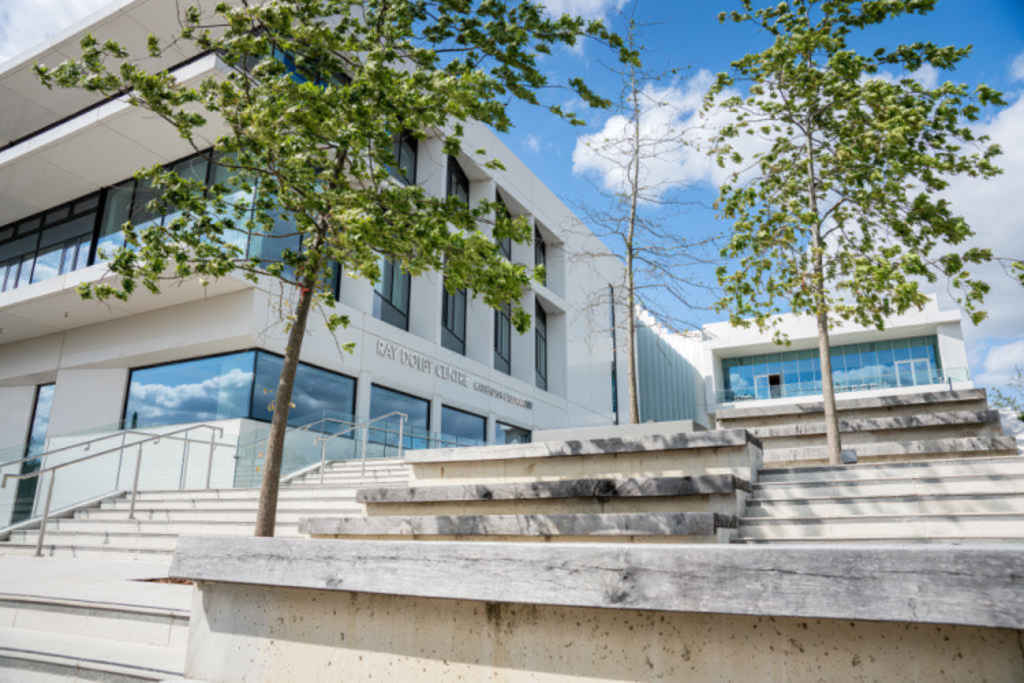
Indi Matharoo, account manager at GVAV, explains how the relationship worked during the two-year project. “UIS has been brought on to create standards within the University, so were heavily involved with this project. We’d worked with them previously, so we understood what they wanted to achieve and there were multiple conversations in order to get this project to where it is today.”
Although much of the building work was completed before GVAV arrived on-site, it didn’t create issues due to its 'clever design', says Mike Rosevear, GVAV’s technical project manager. “The building was designed to have AV from the outset. For example, speaker locations and a large LED wall in the foyer were pre-arranged, making this a purpose-built AV space rather than a retrofit.”
The original AV brief for GVAV focused on creating standards across the University. With many different schools around Cambridge, the goal was to use approved, tested products that had proven performance. According to Matharoo, the University also wanted “bulletproof AV systems” that would be reliable, consistent and easy to support across all environments.
GVAV’s scope included over 30 spaces across four floors, including seminar rooms, teaching labs, meeting rooms, a boardroom, public areas, event spaces and collaborative zones. Chris Brock, AV and digital content specialist at the Cavendish Laboratory, explains that the design process considered what future lecturers would need for teaching, and what spaces required AV for events and flexible uses.

The AV infrastructure is built on a fully converged AVoIP network, delivering video, audio and control over the University of Cambridge’s central IT backbone. This integration allows lecture capture and AV systems to run seamlessly on the same network managed by UIS. All AV equipment is hosted alongside University servers, with all switching handled through their infrastructure.
Crestron NVX forms the video transport system’s core, enabling 4K content distribution to any display without separate matrix switchers. Audio is managed via Q-SYS DSPs, and control is handled through Crestron touch panels that fully integrate with the building’s AV architecture. This unified approach enables scalability, simplified management, and remote monitoring for all spaces.
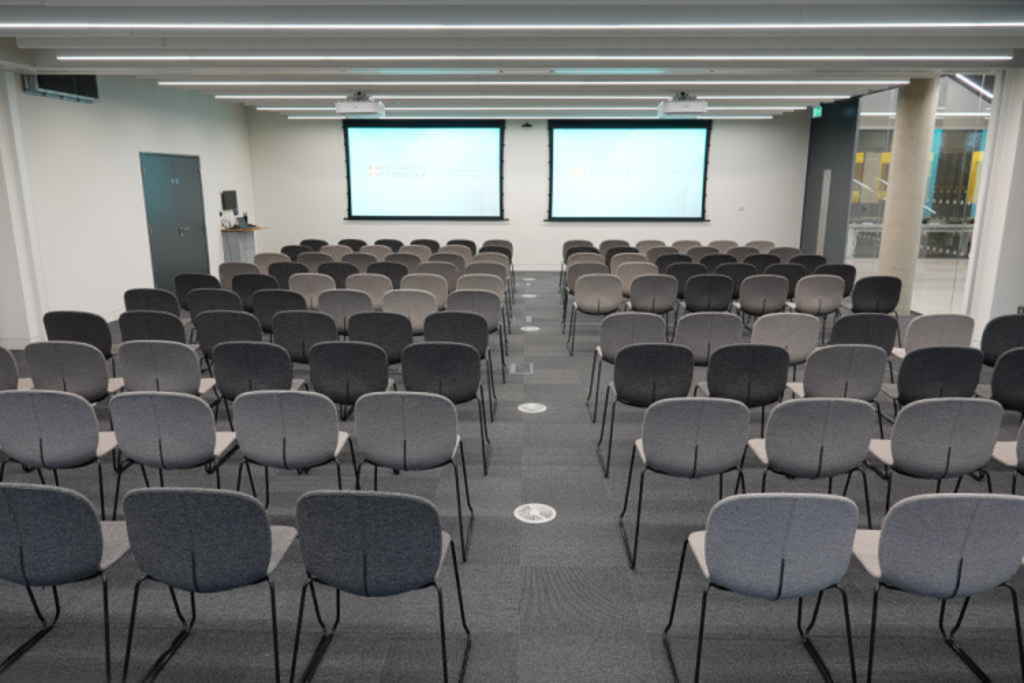
LT1, one of three lecture theatres, features dual 130-inch Samsung LED videowalls with a full-width blackboard underneath, allowing for traditional and digital teaching. The 1.5mm pixel pitch ensures clear viewing, while AV equipment includes dual WolfVision visualisers in a Top-Tec Gemini4 lectern, and Q-SYS PTZ and BirdDog cameras for hybrid capture and Panopto integration.

Shure MXA ceiling arrays and MXW wireless microphones provide full-room audio capture, with AV coverage modelled to AVIXA standards for optimal intelligibility and sightlines. An Epiphan Pearl-2 recording unit integrates directly into the University’s capture system, allowing automatic recording with no user input required.
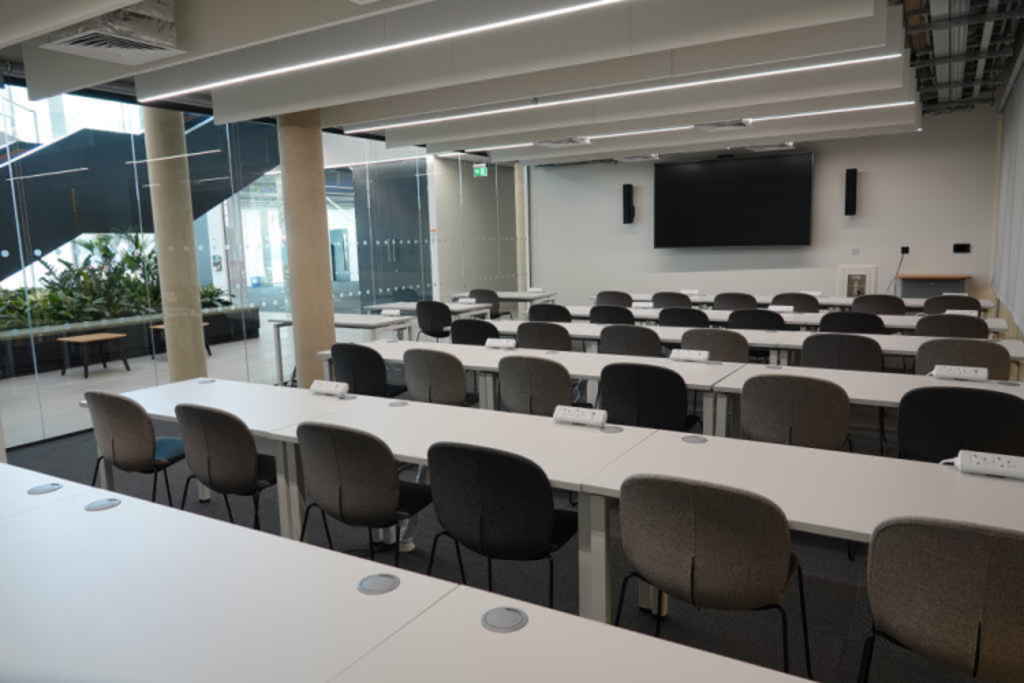
Rosevear highlights that LT1’s design reflects the pedagogy rather than forcing AV into a space. Because physics lecturers often use chalk-based mathematical teaching, the rooms include large blackboards and three Blackmagic box cameras—each capturing a section of the board for Panopto. Viewers can later choose which section to focus on during playback.
Two other lecture theatres, SM1 and LT2, round out the auditorium spaces. SM1 mirrors LT1’s tech with a Samsung LED wall, WolfVision visualisers, and Shure microphones. LT2 uses triple Panasonic projection as its primary display system. All lecture spaces adhere to the University’s AV standards, including direct Panopto integration and Crestron-based control systems.

Microsoft Teams Rooms support hybrid teaching in over 20 rooms, including a dedicated boardroom. David Hunt, project manager at the University’s Department of Physics, notes that collaboration was a key design driver. “The Ray Dolby Centre premises has no dead ends. It’s a big figure of 8. We tried to create spaces that promote spontaneous collaboration,” he says.

Each meeting space features Samsung displays, from 55-inch screens to a 98-inch display in the boardroom. Larger rooms use Q-SYS audio processing, Shure ceiling arrays and PTZ cameras for hybrid use. All rooms are integrated into the AVoIP and control network, enabling quick, intuitive use with consistent University-standard interfaces.
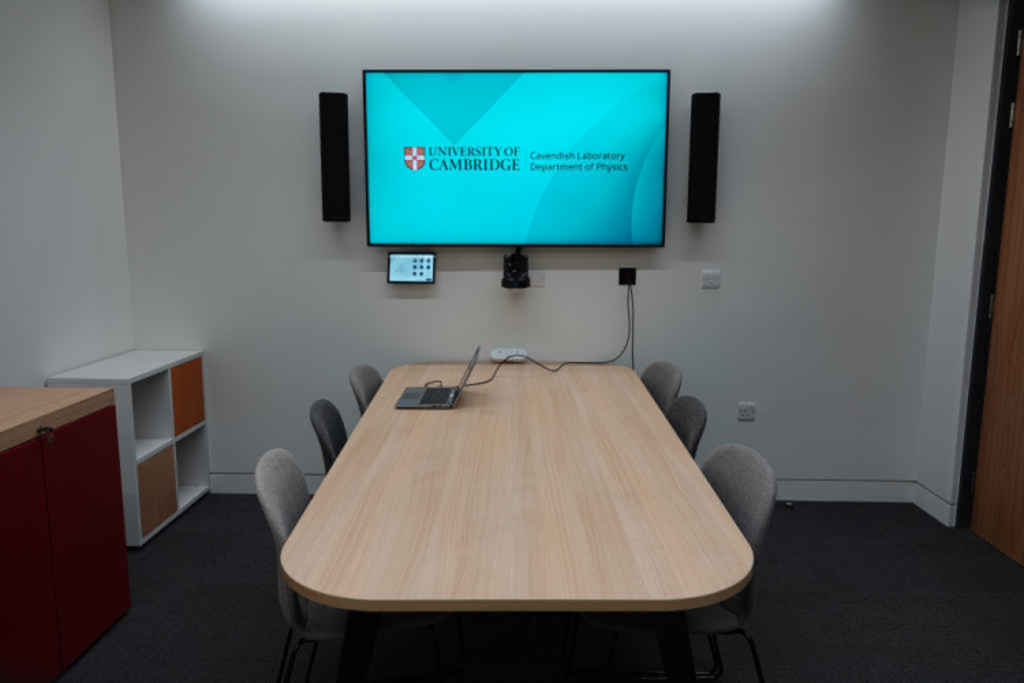
Seminar and teaching spaces also support hybrid learning. Each room includes Samsung displays, Q-SYS and BirdDog cameras, Shure ceiling microphones and Q-SYS audio. This standardised workflow allows academic staff to walk in, connect content and start teaching without additional setup—streamlining the experience and reducing technical barriers.
Specialist teaching labs required subtle AV design due to sensitive equipment. In TR2, three interconnected labs include a curtain-divided darkroom used for light-sensitive experiments. These rooms support hands-on learning and are managed via a technician’s control page, with Epson projectors, Shure MXW microphones, Q-SYS pendant speakers and Crestron touch panels.

Labs were designed with visibility and transparency in mind. “Labs have glass where possible so you can see the research and equipment,” says Hunt. “We continued that concept in nearby spaces with booths and smaller areas to encourage spontaneous collaboration between researchers and students.”
AV also supports wayfinding and communication. Digital signage includes Samsung QM 4K displays and Samsung Flip interactive kiosks. At the foyer entrance, visitors are greeted by a 164-inch LED wall flanked by Q-SYS column speakers, capable of displaying video content and presentations with high-quality sound for public-facing displays.

The café, another shared space, serves as a social hub with two 50-inch Samsung QM 4K displays for digital signage or presentations. Audio is delivered through 12 Q-SYS pendant speakers with dedicated amplification. Control is handled via a Crestron touch panel, offering a user-friendly interface for quick AV adjustments.
As one of the world’s top universities, Cambridge demanded not only high-quality AV but also a flawless aesthetic. Rosevear explains that even speaker cables were colour-matched to fit with architectural elements, with everything modelled in EASE to ensure acoustic and visual harmony. The same design philosophy extended to meeting rooms.
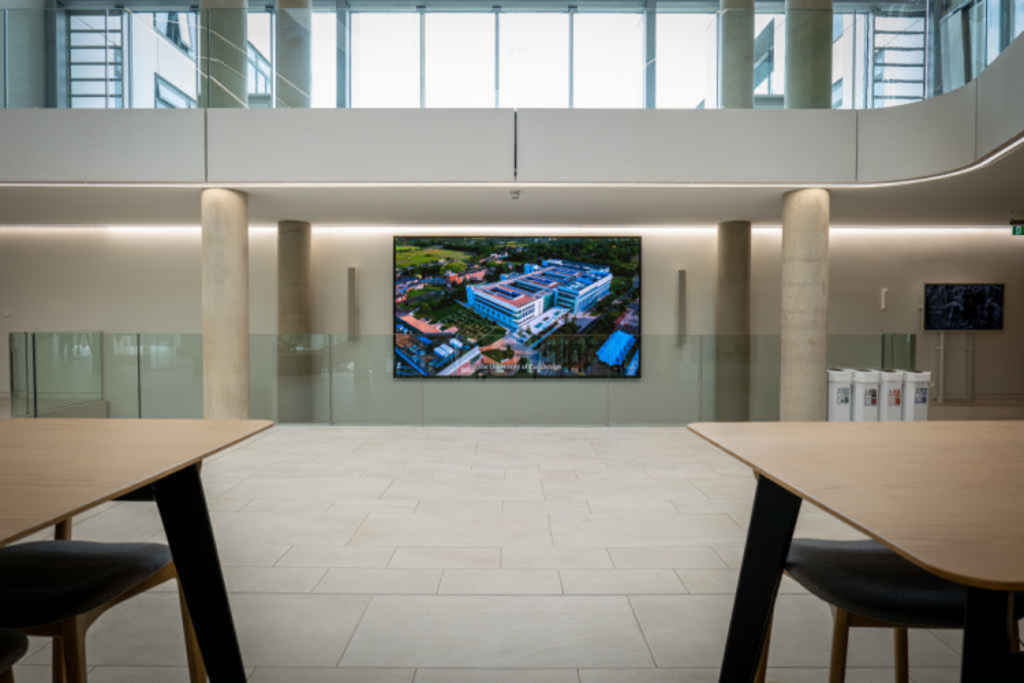
For example, WebEx bars were used discreetly, with touch panels and cabling hidden inside walls. Everything was done with future replaceability in mind. “It’s reusable and was designed for the future of the building as well as the present,” Rosevear adds, reflecting the long-term vision that guided the AV deployment.
Many spaces are flexible by design. PUB1 is a flat-floor event space with two projectors, a removable partition and mobile furniture, suited to exhibitions or outreach. MR3 is a hybrid space for traditional blackboard lectures or boardroom meetings. Extensive data points allow for future upgrades or reconfigurations as needed.

The Ray Dolby Centre is designed to leave a lasting legacy for staff, students and visitors. As a world-class research facility, it aims to build on the Department’s reputation at the cutting edge of experimental physics. Through collaboration between GVAV and UIS, the project has created a benchmark for future academic AV environments.
KIT LIST
Video
Birddog NDI box camera
Epson EBPU2010W 10,000-lumen WUXGA 3LCDprojectors
Samsung QM32B, QM43B, QM50B, QM55B, QM65B, QM85R-B, QM98T-B displays, Flip 55-in interactive displays, IE015A 130-in 1.5mm and IE020A 164-in 2mm LED walls
Screen International projection screens
Q-SYS NC-12x80 PoE PTZ cameras
WolfVision VZ3neo UHD visualisers
Audio
Attero Tech unD6IO-BT interface
Meyer Sound MM-4XP, UP-4Slim, UPM-XP, UP-4XP, Ultra-X40 loudspeakers and MM-10AC subwoofers
Neutrik NA2-IO-DPRO portable I/O bridge
QSC AD-S802TW, AD-P6TB pendant loudspeakers, AD-C6T LP ceiling loudspeakers and AD-S162TW loudspeakers, CXQ2K4, SPA2-200, SPA4-100 and SPA-QF 60x4 amplifiers
Renkus Heinz CA62-RD Dante loudspeakers
Shure MXA920 ceiling array microphones, MXW2/SM86 handhelds, MXWAPT access point transceivers, MX412 gooseneck and MX202 overhead microphones
Williams Sound IR transmitters, modulators, emitters, receivers and charging cases
Control & Processing
Cisco Webex Room Bar
Crestron DM-NVX encoders, decoders and cards, CP4 control processors, TSW-770 7-in touch panels and TSS-770 touch screens, occupancy sensors and I/O modules
Epiphan Pearl 2 and Pearl Mini video production systems
Extron USB-C HD 101 converters, HDMI switchers, Cable Cubby enclosures
Furniture & Infrastructure
Chief flat-panel mounts and component storage panels
Furman AC-210 and PL-8C rackmount power conditioners
Lindy Thunderbolt 3, HDMI, and USB cables
PanaVise mounts
TK Team dual boards
Top-Tec Gemini4 lecterns, Juno wall-mounted workstations, and preparation tables
Unicol ceiling plates, poles and projector mounts